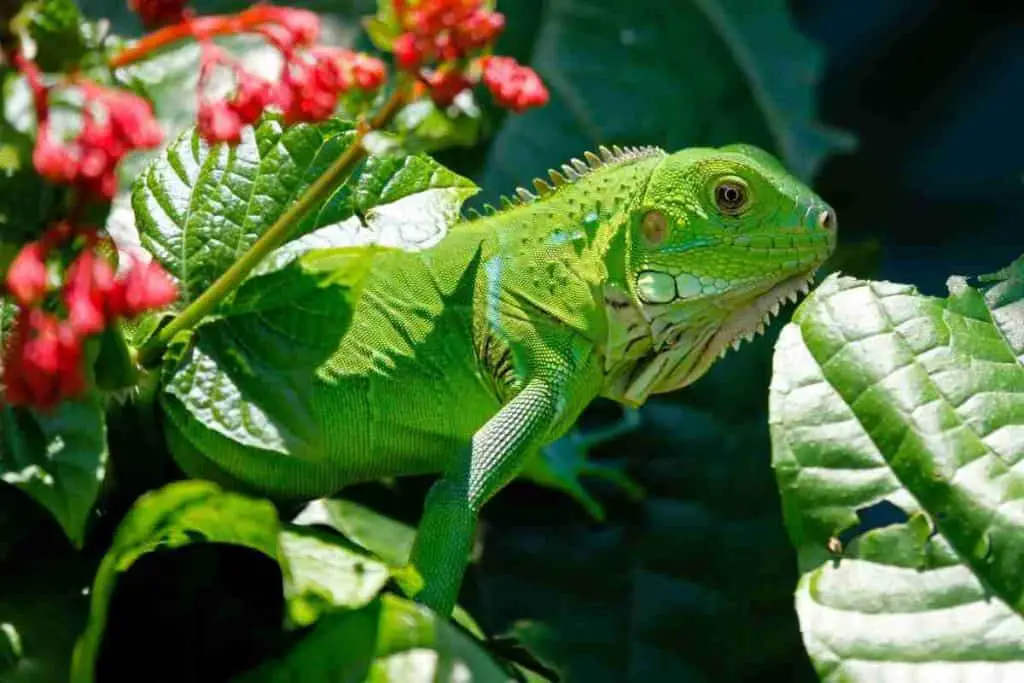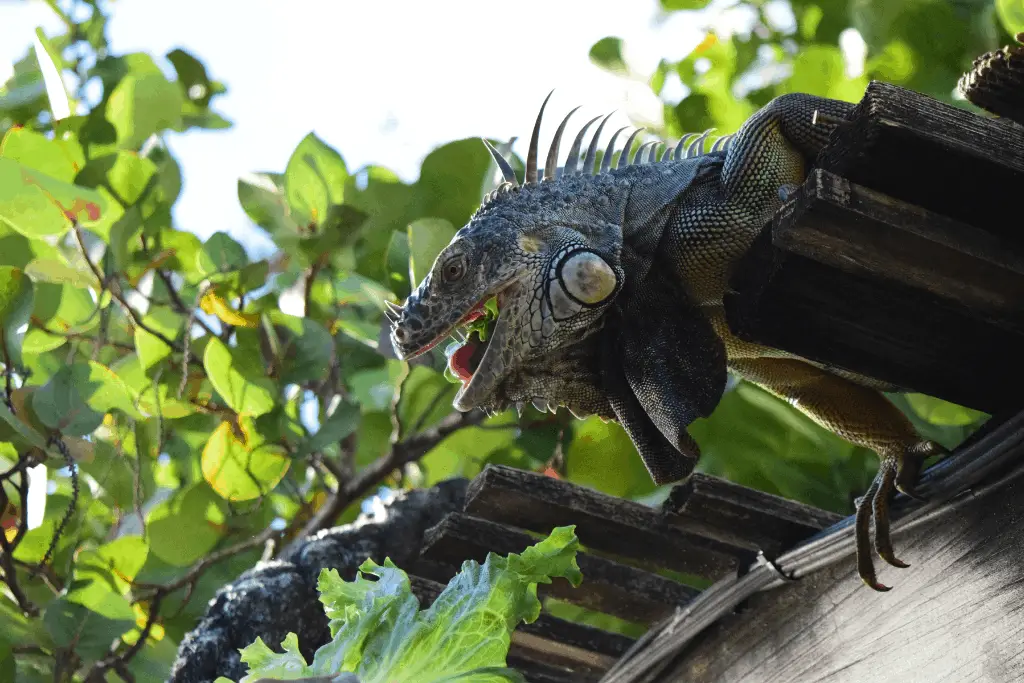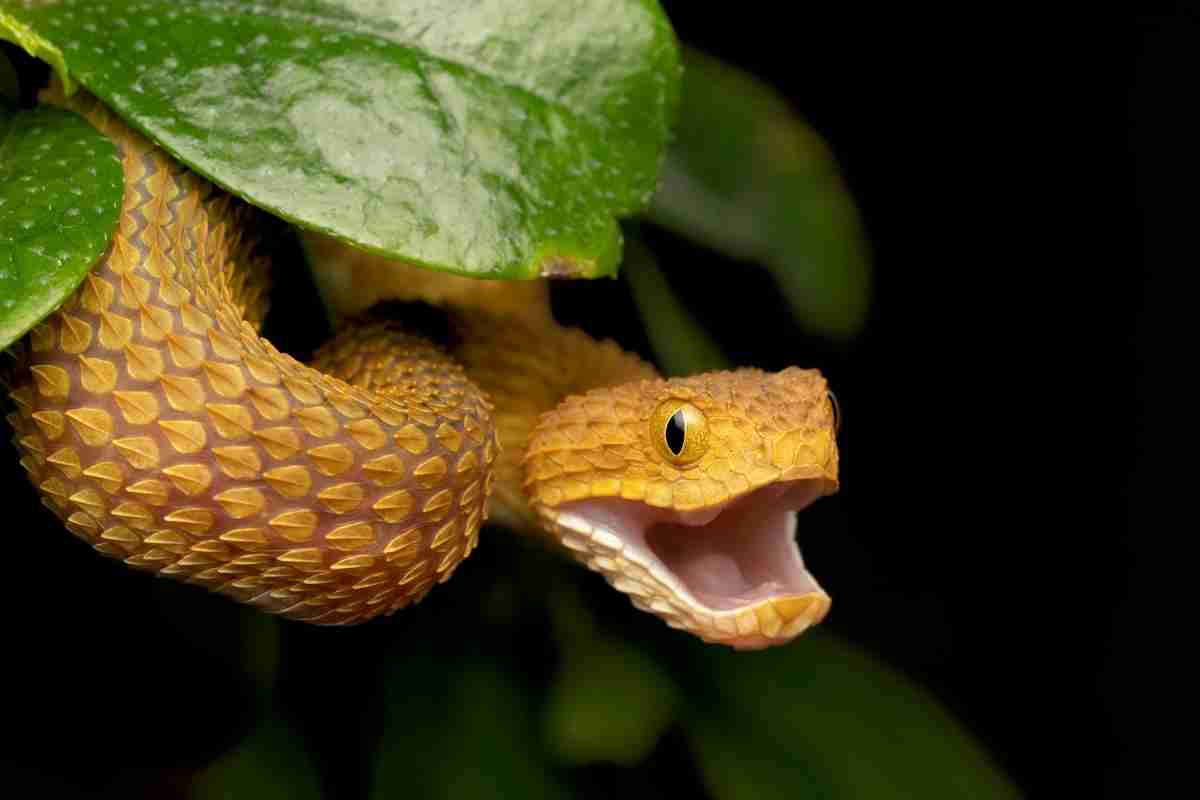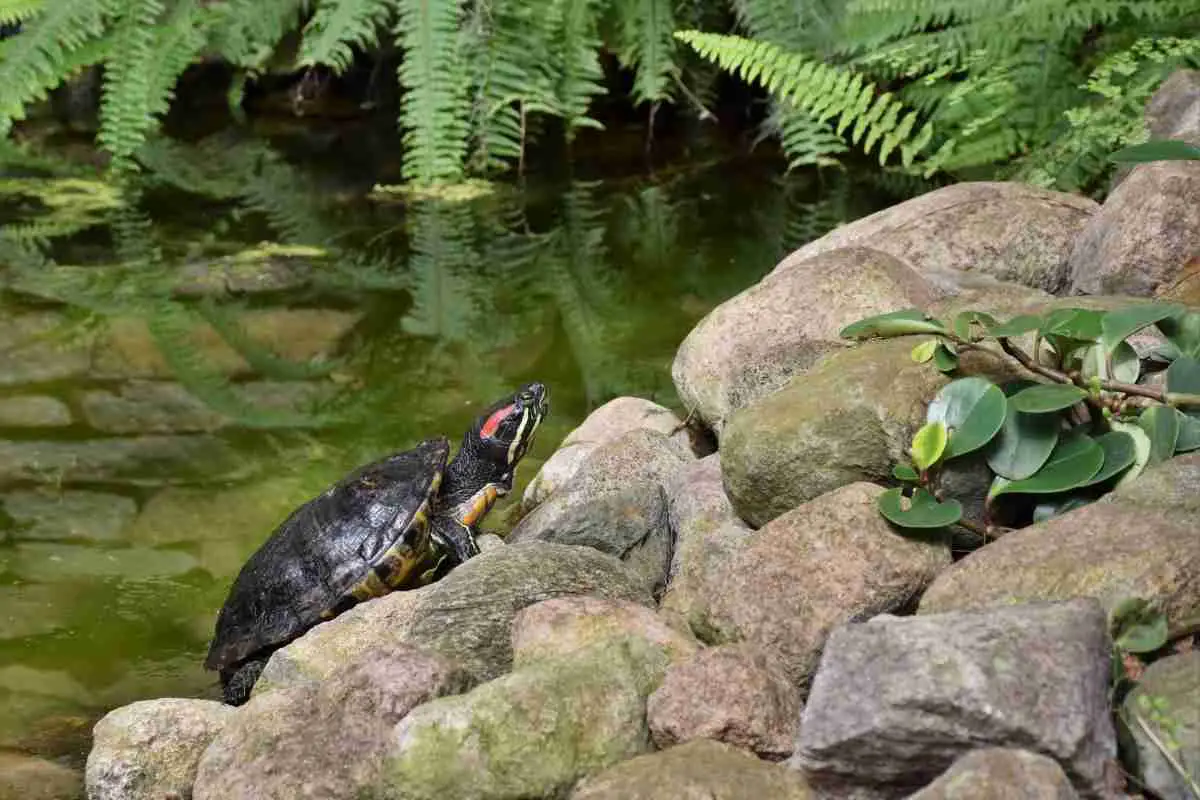The iguana is an herbivorous lizard that is native to tropical areas of Central and South America, Mexico and the Carribean. Although there are a couple of iguana species, by far the most common is the green iguana, which is common in the wild and is a very popular pet. Iguanas became established in areas outside of their native range through a combination of shipping via the fruit trade, and releases from pet owners into the wild. Today, iguanas are considered an invasive species in Florida and cause considerable damage to the natural environment as well as destruction of residential and landscaping vegetation.
In this post, we will specifically talk about what iguanas eat in the wild. We’ll discuss what the different types of iguanas eat, and look into the diets of both young and adult iguanas.
What Do Iguanas Eat?
Typically, wild iguanas spend most of their life in the upper parts of trees. Most often, they eat leaves and spend time soaking up the sun’s ultraviolet (UVB) rays, which helps in their overall digestion and bone growth.
That’s why these species are known as “folivores” instead of herbivores, carnivores, or omnivores.
Iguanas feed on a wide range of leafy greens, fruits, and vegetables. Leafy greens make up 70% of their diet, followed by vegetables at 20%.
These reptiles have a variety of tastes, which means they prefer different foods. Interestingly, iguanas prefer collard greens, turnip greens, mustard greens, endive, escarole, and dandelion greens in the wild.
Iguanas can eat quite different foods depending on local availability. For example, in Central America iguanas will eat fruits like apples, papaya, grapes, strawberries, bananas, berries, cherries, kiwi, and persimmons.
If they are available in the wild, Iguanas can also feed on bell peppers, carrots, squash, yams, zucchini, and parsnips.
Some species of native iguanas also feed on insects in the wild, which vary by location.
For example, online research shows that in South America, Central America, and other parts of the continent, iguanas sometimes eat worms, flies, crickets, spiders, and ants.
However, most iguanas are strict herbivores (or ‘folivores’, if you will). They can’t easily process intense proteins and fats found in animal tissues because their digestive system is not specifically designed for it.
Iguanas don’t eat all vegetables that are available, though. Foods that iguanas avoid eating in the wild include chard, spinach, and kale. These food items can negatively impact their body, especially in terms of calcium uptake.
Again, you should keep in mind that the diet of iguanas consists mainly of leafy greens and flowers. They have a digestive system which efficiently extracts essential nutrients, including proteins and vitamins from plants, including green leaves.
Related Article
What Do Young Iguanas Eat In The Wild?
Iguanas are reptiles that come from eggs. Online research shows that the mother iguana lays about 40-50 eggs by digging a hole in the ground and building a nest, where she lays eggs and cares for her baby iguanas after their birth. Although adult iguanas typically feed on leaves and other vegetation, baby iguanas have a different diet than adults because they have different nutritional needs. Young, growing iguanas are omnivores, meaning they eat both plants and meat. Baby iguanas need the protein source in their diet to support bone and muscle growth. As a result, baby iguanas feed on a variety of insects, snails and carrion. While such a diet can harm the health of adult iguanas, it is healthy for the growth and development of young iguanas. As young iguanas grow older, their diet shifts away from insects and toward a folivore diet.
What Do Adult Iguanas Eat In The Wild?
Not all iguanas are strictly folivorous creatures. They may eat insects in the wild at times to balance their protein requirements, but still the bulk of green iguanas in the wild eat foliage, fruits, and flowers. These species eat plant-based food that favors their digestive system and metabolism.
Most of the flowers and foliage wild iguanas eat come from greasewood. Iguanas also eat flowers of sand verbena, which is a favorite food item for desert iguanas.
Some iguanas also eat fecal matter, which is either their own or from other reptiles. Adult iguanas in the wild are not very likely to eat insects. At the same time, they don’t have any predisposition for yellow plants and leaves.
Research shows that wild iguanas may eat tree snails, grasshoppers, and birds’ eggs, but eating too much of these items can cause kidney disorders and eventually premature death. According to Adam Britton, a famous zoologist, protein-rich food items are not useful for an iguana’s digestive system.
Moreover, leafy greens are by far the most essential part of the iguana’s diet, particularly for adult iguanas. Iguanas have 85% leafy food content is their stomach, which is primarily healthy for their digestive systems.
Fruit & Vegetables Iguanas Can Eat
| Leafy Greens | Vegetables | Fruits |
| Kale | Cucumber | Apple |
| Collard | Carrots | Kiwis |
| Parsley | Peas | Strawberries |
| Mustard Greens | Okra | Tomato |
| Turnip Greens | Bell Pepper | Grapes |
| Romaine Lettuce | Sprouts | Melons |
| Dandelions | Leaks | Peaches |
Remember, most often, these reptiles will feed on green leaves and flowers. However, if fruits and vegetables are available in the wild, they won’t hesitate to eat them. Vegetables and fruits provide Iguanas with essential nutrients, such as vitamins, minerals, and antioxidants that balance the overall homeostatic function of the body.
What Do Cuban Iguanas Eat In The Wild?
In general, scientists say that the Cuban iguana is an herbivore, which means over 90% of its diet consists of leaves, vegetables, fruits, and flowers.
Cuban iguanas feed on 30 different plant species, including olives, red mangrove, black mangrove, thistle, pear, rock shrub, and various other types of grasses.
Cuban iguanas are quite different from green iguanas in terms of traits. For example, the skin of male iguana ranges from brick red to dark grey.
Likewise, the female Cuban Iguana is olive green with bands or dark stripes on the body. Cuban iguanas rarely eat animal matter. They sometimes feed on dead crabs, fish, and birds in the wild.
Compared to various other reptiles, wild iguanas, particularly Cuban iguanas, suffer from an osmoregulation problem. It means these iguanas need potassium to maintain their metabolic needs.
Because Cuban iguanas feed on plants, they need to consume more plant matter to get the right amount of potassium.
While most Cuban iguanas feed on leaves and flowers, some of them eat wax worms, mealworms, and crickets. Waxworms are a rich source of fat for iguanas, and that’s why they eat them to keep up the fat content.
So, considering the above factors, I must say that primarily, these iguanas are herbivores unlike green iguanas, which are folivores (leafy green eaters). They feed on leaves (both green and yellow), flowers, and fruits.
In general, they live on rocks and are good climbers. While searching for food, if they are threatened, they will leap from great heights, often from a branch, and escape.
When they are in need of carrion or snails Cuban iguanas are tough enough to land on hard ground and catch their prey.
Related Article

What Do Rhinoceros Iguanas Eat In The Wild?
Another question that arises in the mind of reptilian lovers is what do Rhinoceros iguanas eat in the wild?
Before I tell you about the diet of this species, I will briefly give you some information on its habitat so that you can associate it with the food.
The natural habitat of the Rhinoceros iguana is desert and dry forest. This type of environment receives very little rain, is arid and sun-drenched, and does not contain readily available leafy greens for iguanas to eat. So, mostly shrubs, small trees, mesquite, and cacti surround the burrows that these species usually inhabit.
Remember, iguanas, in general, exhibit a significant amount of flexibility while choosing their habitat, and the interesting thing is that the Rhinoceros iguanas are no exception.
These reptiles have a variable diet both ontogenetically and seasonally.
Like the Cuban iguanas and green iguanas, they eat a wide variety of leaves, flowers, seeds, and fruits. It is essential to know that sometimes, these reptiles also eat animals, such as land crabs, insects, and dead carrion of fish and birds.
Baby Rhinoceros iguanas will often take insects, including snails/grasshoppers, and other small animals. These iguanas look for a food source, such as a fruiting bush, and defend it from other animals.
Other species, such as Hypomelanistic iguana, Chuckwalla, Spiny Tailed Iguanas, Grand Cayman Iguana, Fiji Banded Iguana, and Galapagos Land Iguana eat leaves, flowers, vegetables, and fruits.
Edible Plants For Wild Iguanas
Most reptilian enthusiasts want to know about edible or non-toxic plants for iguanas. These reptiles are hindgut fermenters, requiring special bacteria and flagellate microbes to ferment foods that contain high levels of fiber.
They need this mechanism for the absorption of nutrients in the lower intestines, which is then used by the body. That’s why they feed on plants. Let me talk about some of the most edible plants for wild iguanas.
Opuntia
Also known as pear cacti, Opuntia is the most edible plant for iguanas. The pads and fruits of this plant are a good food source for iguanas. There are some forms of Opuntia which have larger spines that are dangerous to the health of iguanas.
Likewise, it is important to know that the pear cactus plant is not suitable for green iguanas and other tropical reptiles. However, they are a good food source for other kinds of iguanas, such as desert iguanas and Cuban iguanas because they live in dry habitats.
Hibiscus Rosa-Sinensis
Although there is no solid evidence of the origin of this plant, many people call it the Chinese hibiscus. The plant grows large, which is beneficial for iguanas in terms of food. In general, Hibiscus is safe for these reptiles to consume.
Some varieties of hibiscus flowers are neurologically toxic while others are completely safe for iguanas. By nature, iguanas will tend to avoid the toxic ones.
However, if they are removed from their natural habitats, they can mistakenly eat the toxic ones.
Epipremnum Aureum
Also known as the golden pothos, this plant is best for iguanas and other reptiles in the wild. Some forms of this plant have potential toxicity, but they are generally safe for iguanas to consume.
The plant is toxic for other wild animals, such as dogs.
Invasive green iguanas eat golden pothos. Iguanas do not eat it most often because it can cause mild digestive issues. Well, it might be true, but there is still a need for more research.
Nephrolepis Exaltata
Nephrolepis exaltata is also known as sword fern or Boston fern. Although it is a famous houseplant, it also grows in the wild. There are many structural differences between wild and domestic varieties.
Generally, the plant is non-toxic for human beings and animals, including dogs and cats. Similarly, the wild form of this plant is suitable for iguanas to consume. So, iguanas can eat this plant if it is available in their habitat.
Boston fern is most suitable for green iguanas as it exists in a tropical environment. It is a dense, bushy plant and a rich source of essential nutrients like phosphorus, nitrogen, and potassium for iguanas.
What Foods Are Toxic For Iguanas In The Wild?
Like any other reptilian species, iguanas look for food that keeps them healthy. Some people believe that all animal species are conscious about their food safety.
Science has shown that animals removed from their native habitats can eat things that are harmful to their health. There is an apparent connection between the natural environment an iguana is adapted to and its ability to understand the beneficial and harmful foods in that environment.
In general, wild iguanas avoid eating dead meat and insects. They stick to leaves, flowers, plants, and fruits. However, some plants, such as kale are a rich source of goitrogens that can cause thyroid issues in wild iguanas.
As mentioned above, iguanas removed from their native habitat tend to eat kale, which causes serious complications.
Moreover, spinach in the wild is a harmful choice, especially for green iguanas. It is a plant with high levels of oxalate content that can lead to the binding of calcium absorption in iguanas.
As a result, the problem can cause metabolic bone disease. Sometimes, it even causes premature death of these reptiles.
Furthermore, iguanas will avoid eating animal protein, such as dead meat, carrion, insects, etc. It is because they are obligate folivores or herbivores.
Their bodies can’t process animal proteins, but when they eat animals, it can put strains on their liver and kidneys. Thus, this causes liver or kidney failure and leads to the death of the iguana.
Toxic plants for wild iguanas include Amanita, Azalea, Baneberry, Black locust, Boxwood, Daffodil, Ergot, Foxglove, Ghostweed, Honeysuckle, Ivy, Lantana, Lobelia, Malanga, Mexican breadfruit, Moonseed, Narcissus, Periwinkle, Pokeweed, Rosary peas, and hundreds of other plant species.
Iguanas gain a protein boost from plant-based food that is valuable for weathering harsh climates, especially during winter.
Iguanas are herbivores and folivores, which means they eat plants to keep their body healthy and fully functional.
Conclusion
Iguanas are lizards and lizards are reptiles. According to the San Diego Zoo, there are around 4,675 lizard species. Other reports show that there are about 6,000 lizard species.
Most lizards are carnivores in nature, which means they consume meat. Typically, their diet is spiders, ants, cicadas, and other small animals. Some lizards even eat shells, such as snails.
Some lizards are omnivorous, which means they eat both animals and plants. When it comes to omnivores, some iguanas eat both plants and carrion.
However, since leafy greens make up 85% of the iguana’s diet, scientists are still not sure about categorizing them as omnivores.
Some lizards, such as green iguanas, are folivores because they feed on leafy green plants in the wild. If available, these iguanas also eat wild fruits and vegetables to fulfill their nutritional requirements.




